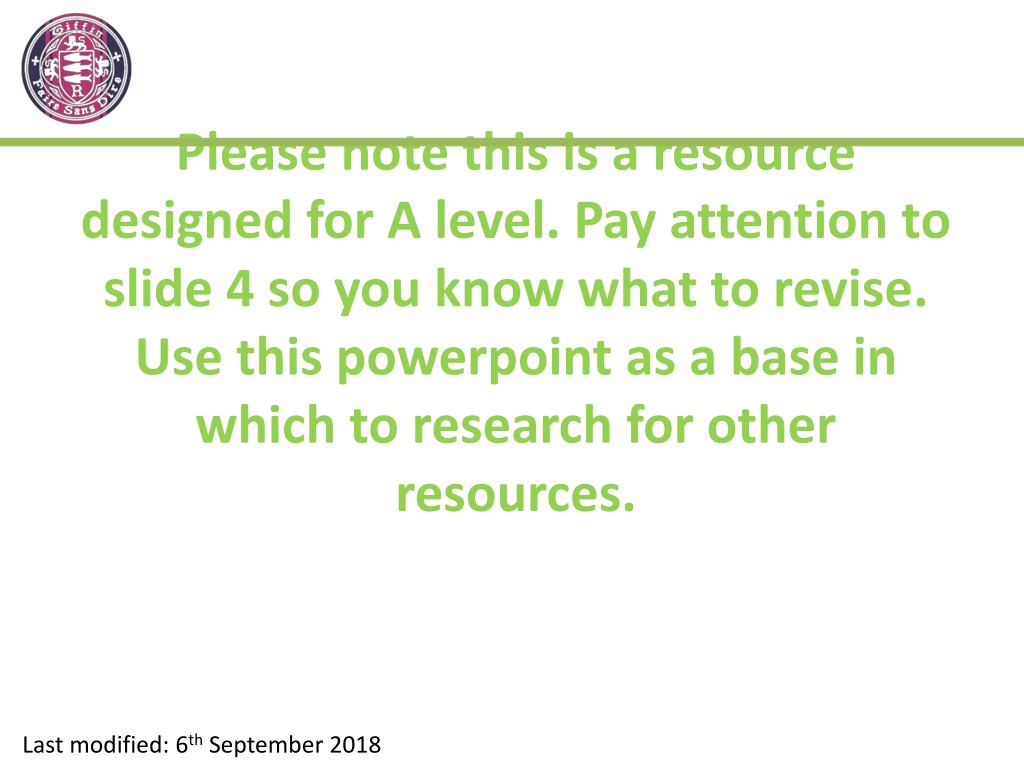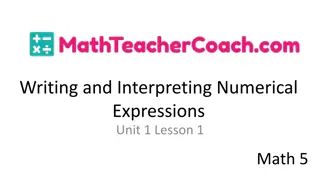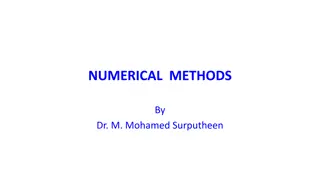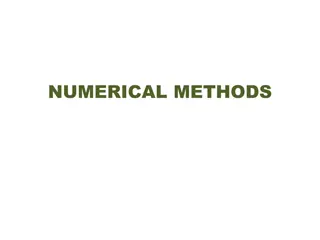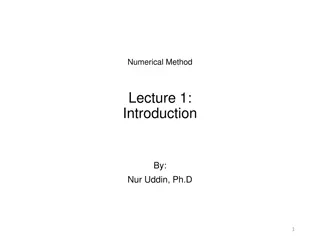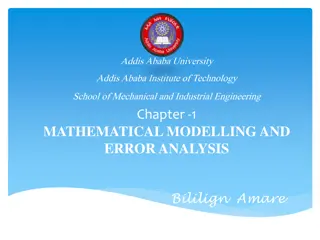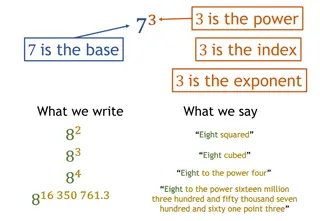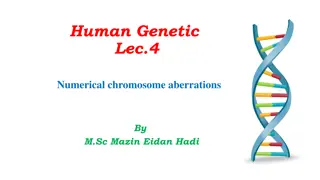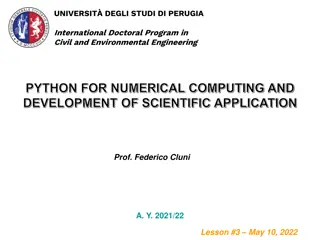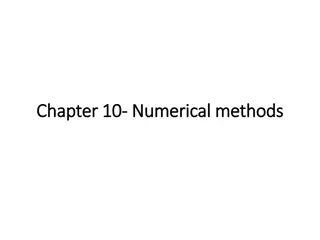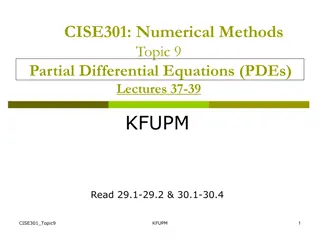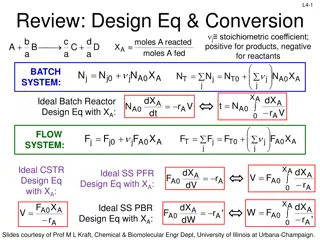Understanding Numerical Methods in Mathematics
Explore the world of numerical methods in mathematics, focusing on the Newton-Raphson Method and root approximations. Discover how to locate roots of equations and use iteration to enhance your problem-solving skills. Uncover the significance of numerical methods in finding solutions to complex equations that defy algebraic expression. Dive into practical examples and tips for successfully applying these methods in your mathematical endeavors.
Download Presentation

Please find below an Image/Link to download the presentation.
The content on the website is provided AS IS for your information and personal use only. It may not be sold, licensed, or shared on other websites without obtaining consent from the author. Download presentation by click this link. If you encounter any issues during the download, it is possible that the publisher has removed the file from their server.
E N D
Presentation Transcript
Please note this is a resource designed for A level. Pay attention to slide 4 so you know what to revise. Use this powerpoint as a base in which to research for other resources. Last modified: 6th September 2018
P2 Chapter 10 :: Numerical Methods jfrost@tiffin.kingston.sch.uk www.drfrostmaths.com @DrFrostMaths Last modified: 6th September 2018
www.drfrostmaths.com Everything is completely free. Why not register? Register now to interactively practise questions on this topic, including past paper questions and extension questions (including MAT + UKMT). Teachers: you can create student accounts (or students can register themselves), to set work, monitor progress and even create worksheets. With questions by: Dashboard with points, trophies, notifications and student progress. Questions organised by topic, difficulty and past paper. Teaching videos with topic tests to check understanding.
Chapter Overview In the GCSE9-1 syllabus you covered iteration , which allowed you to find successfully better approximations to the solutions of an equation. We ll revisit this, but also see a more powerful method for approximating solutions. 1:: Locating Roots 2:: Using iteration to approximate roots to ? ? = 0 What it means to find the root of an equation and when we can be sure a root lies in a stated range. Show that ? ? = ?3 4?2+ 3? + 1 has a root between ? = 1.4 and ? = 1.5 . 3:: The Newton-Raphson Method A numerical method that tends to converge to (i.e. approach) the root faster, by following the tangent of the graph. ??+1= ?? ? ?? Not needed for Ad Maths ? ??
Why do we need numerical methods? Terminology Pedantry: We often say Find the roots of ?2+ ? = 0 , i.e. an equation in the form ? ? = 0, which really means Find the roots of the function ? ? where ?(?) = ?2+ ? . But we wouldn tsay Find the roots of ?2 ? = 6 , but Find the solutionsof . So to find roots is to find the ? such that the output , or one side of the equation, is 0. Finding the root of a function ? ? is to: solve the equation ? ? = ? (i.e. the inputs such that the output of the function is 0) ? However, for some functions, the exact root is either complicated and difficult to calculate: ? =1 13 3 ? ??+ ??? ?? + ? = ? 2 89 6 159 3 389 6 159 or there s no algebraic expression at all! (involving roots, logs, sin, cos, etc.) ? Exact solution not expressible ? ??? ? = ? But there are a variety of numerical methods which get progressively better solutions to an equation in the form ? ? = 0. You have already seen iteration at GCSE as one such method. Root
Proving a solution lies in a range Show that ? ? = ??+ 2? 3 has a root between ? = 0.5 and ? = 0.6 ? 0.5 = 0.351 ? 0.6 = 0.022 There is a change in sign, and ?(?) is continuous, so root must lie between 0.5 and 0.6 ? Bro Exam Tip: In the mark scheme they re looking for: 1. Finding the function output for the two values. 2. Referring to a change in sign . If the ? value goes from negative to positive or vice versa, then clearly the ? values must pass 0 somewhere in between. 0.6,0.022 0.5, 0.351
but only if the function is continuous Stupid Steve says: 1 ?, then When ? ? = ? 1 = 1 and ? 1 = 1. There is a change in sign therefore ?(?) has a root in the range [-1, 1] Why is Steve wrong? ? A function is continuous if the line does not jump . A root is only guaranteed with a sign change if the function is continuous, as otherwise the line can skip past 0 (in this case due to a vertical asymptote. (1,1) ? ( 1, 1)
and no sign change doesnt mean there isnt a root ? Beware! Just because there isn t a sign change, doesn t mean there s no root in that interval. root root ? The sign change method fails to detect a root if there were an even number of roots in that interval.
Proving a solution to a given accuracy Edexcel C3 Jan 2013 Thinking back to lower school, if the root 2.307is correct to 3dp, what s the smallest and greatest value it could be? ? 2.3065 2.3075 ? Smallest: Greatest: If there was a sign change between ? = 2.3065 and ? = 2.3075, then we know 2.3065 < ? < 2.3075. But if the value is in this range, then we know it is 2.307 to 3 decimal places! ? ?.???? = ?.?????? ? ?.???? = ?.????? ? What do we write in exam There is a change in sign in the interval (?.????,?.????) ?.???? < ? < ?.???? ? = ?.??? ?? ???
Exercise 10A Pearson Pure Mathematics Year 2/AS Pages 276-277 (Classes pressed for time may wish to skip this exercise)
Does the starting value ?0 matter? Yes! We ll see why in a bit when we look at staircase and cobweb diagrams. If there are a multiple roots, iteration might converge to (i.e. approach) a different root. Or we may not converge to a root at all, and diverge (i.e. approach infinity). [Textbook] ? ? = ?3 3?2 2? + 5 (a) Show that the equation ? ? = 0 has a root in the interval 3 < ? < 4. 3 2??+5 3 ?? (b) Use the iterative formula ??+1= and ?3, giving your answers to 4 decimal places, and taking: (i) ?0= 1.5 (ii) ?0= 4 to calculate the values of ?1, ?2 (a) ? 3 = 1 ? 4 = 13 There is a change in sign in the interval 3 < ? < 4 and ? is continuous, so there is a root of ?(?) in this interval. (b) (ii) ?1= 4.5092 ?2= 5.4058 ?3= 7.1219 ? ? The series is divergent, so iteration has failed. 1.53 2 1.5 +5 3 (b) i) ?1= = 1.3385 ?2= 1.2544 This appears to be convergent as the change in the root on each iteration is becoming smaller. ,?3= 1.2200 ?
Test Your Understanding Edexcel C3 June 2012 Q2 Warning: Any particular mark scheme gives what is minimally acceptable. So you should use the full wording earlier to avoid the risk of mark loss. ? ? ?
Why does this method work? Solve ?2 ? 1 = 0 Recall we put in the form ? = ? ? : in this case ? = We can then use the recurrence ??+1= ? + 1 is one possible rearrangement. ??+ 1 . Why does this recurrence work? This is called a staircase diagram due to its shape. We can see that we re converging towards the root ?. Finding the solution to ? = ? + 1 is the same as sketching ? = ? and ? = ? + 1 and seeing the point at which they intersect. This value of ? is the root of the original equation. This gives ?1= 1.414 This is then fed back into ??+ 1 for the next iteration, i.e. the ? value becomes the new ? value! This is equivalent to moving to the line ? = ?. ?? ? ?? When ?0= 1, we would find ?0+ 1. This is the ? value on the ? = graph. We can repeat this process using ?1= 1.414 to get ?2 and so on. ? + 1
Cobweb Diagrams Solve ?2 ? 1 = 0 1 We could also have rearranged differently to ? = ? 1 1 Therefore we use the recurrence ??+1= ?? 1 . What happens this time? ?? ? ?? ?? ?? ? ? = ? ? This is unsurprisingly called a cobweb diagram. Again we can see that we re successfully converging towards the root ?.
And when iteration fails Solve ?2 ? 1 = 0 But again, we could have rearranged differently! ? = ?2 1 Therefore we use the recurrence ??+1= ?? 2 1 . What happens this time? The root approximations ?? are getting further away from the true root ?, not closer, so our iterative method failed. ?? ? ??
Test Your Understanding ? ? = ?2 8? + 4 (a) Show that the root of the equation ? ? = 0 can be written as ? = (b) Using the iterative formula ??+1= staircase diagram, indicating ?0,?1,?2 on your ?-axis, as well as the root ?. 8? 4 8?? 4, and starting with ?0= 1, draw a ? = ?? ? ? ? ?? ?? ??
Exercise 10B Pearson Pure Mathematics Year 2/AS Pages 280-282
The Newton-Raphson Process (also known as Newton s method) We wish to find the root ?. Suppose we start with the indicated approximation of the root, ?0. Clearly this is well off the mark! ? A seemingly sensible thing to do is to follow the direction of the line, i.e. use the gradient of the tangent. If the line was reasonably straight, the point the tangent hits the ?-axis would be close to the root. We can keep repeating this process to (hopefully) get increasingly accurate approximations. Can you come up with a formula for ??+1 in terms of ??? ? ? ?2 ?1 ?0
The Newton-Raphson Process y Formula: Using Year 1 coordinate geometry: ? ? ?? = ? ?? ? ?? But we re interested when ? = ??+1 and ? = 0 ? ?? = ? ?? ??+? ?? ? which rearranges to give: Newton-Raphson Process: ??+1= ?? ? ?? ? ?? ? Exam Note: Pearson didn t include the above proof in their own textbook, so I can only presume you won t be tested on the proof. ??+1 ??
A nice animation Demo (Courtesy of Wikipedia) This is German, but I ll presume you re not an idiot.
Example Returning to our original example: ? = ??? ? ,say letting ?0= 0.5 (Note: Recall that differentiation assumes radians) Let ? ? = ? ??? ? ? ? = ? + ??? ? This ensures we have an equation of the form ? ? = 0 ??+?= ?? ?? ??? ?? ? + ??? ?? ??= ?.? ?.? ??? ?.? ? + ??? ?.? ??= ?.??????? ??= ?.??????? = ?.?????????? ? Fro Tip: To perform iterations quickly, do the following on your calculator: [0.5] [=] [ANS] (ANS cos(ANS))/(1 + sin(ANS)) Then spam [=]. After merely three iterations, our approximation is accurate to 7 decimal places. Holy smokes Batman!
Quickfire Questions Using the Newton-Raphson process, state the recurrence relation for the following functions: ? ? ?? ?? ? ?? ? ? = ?3 2 ??+?= ?? ??+?= ?? ????? = ?? ? ? ? = tan? ? ???? ??? ?????? ?? ??? ? ? ?? ? ? ? ? = ?2 ? 1 ??+?= ??
Example Exam Question Edexcel FP1 June 2013(R) Q3c ? ??? ? ?? ? ?? ?+ ?? ? ??+?= ?? ? ? ?? ?+ ? ? ??= ?.? ?.????? = ?.???? ??.?
Test Your Understanding Edexcel FP1 Jan 2010 Q2c ?
When does Newton-Raphson fail? ? If the starting value ?? was the stationary point, then ? ?0 = 0, resulting in a division by 0 in the above formula. tangent Graphically, it is because the tangent will never reach the ?-axis. ? ?0 ? ? = Newton-Raphson also suffers from the same drawbacks as solving by iteration, in that it s possible for the values of ?? to diverge. In this example, the ?? oscillate either side of 0, but gradually getting further away from ? = 0. 1 + ?2 ? ? ?1 ?0 ?2
Exercise 10C Pearson Pure Mathematics Year 2/AS Pages 284-285
Application to Modelling [Textbook] The price of a car in s, ? years after purchase, is modelled by the function ? ? = 15 000 0.85? 1000sin?, (a) Use the model to find the value, to the nearest hundred s, of the car 10 years after purchase. (b) Show that ? ? has a root between 19 and 20. (c) Find ? ? (d) Taking 19.5 as a first approximation, apply the Newton-Raphson method once to ?(?) to obtain a second approximation for the time when the value of the car is zero. Give your answer to 3 decimal places. (e) Criticise this model with respect to the value of the car as it gets older. ? > 0 ? 10 = 3497.13 3500 a d In reality, the car can never have a negative value so this model is not reasonable for cars that are approximately 20 or more years old. ? ? b ? 19 = 543.11 > 0 ? 20 = 331.55 < 0 There is a change of sign between 19 and 20, so that is a root in the interval 19 < ? < 20 ? ? ? = 15 000 0.85?ln0.85 1000cos? ? 19.5 = 25.0693 ? 19.5 = 898.3009 ?1= ?0 ? ?0 ? ?0 c ? = 19.528
Exercise 10D Pearson Pure Mathematics Year 2/AS Pages 287-289
